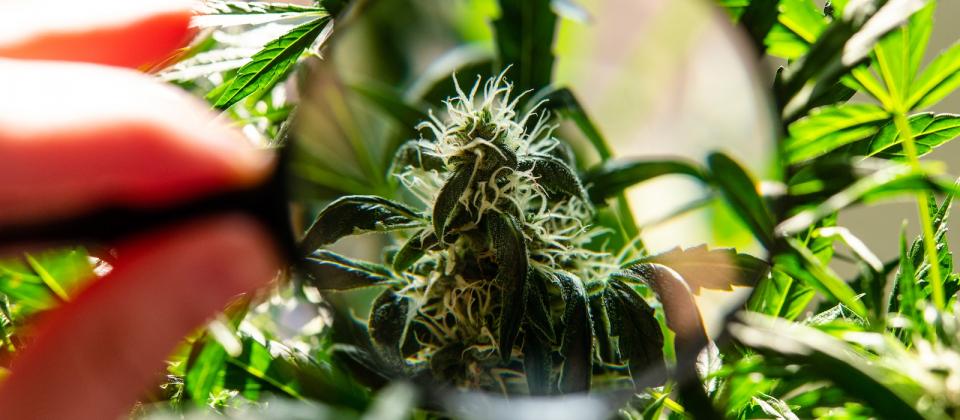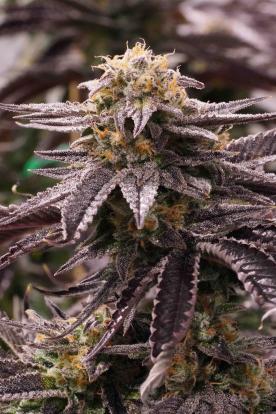Out of the hundreds of terpenes found in cannabis, the most abundant is myrcene (also known as beta-myrcene or β-myrcene). Many cannabis strains are composed of other ‘main’ terpenes, like limonene, pinene, or linalool. But myrcene is really on another level: it can account for 50% of the terpene content in a plant. Keep reading to find out more about this compound.

Due to the fact that it is the most common terpene found in cannabis, myrcene is also the most thoroughly studied. This natural organic hydrocarbon can also be found in fruits like mango, and in herbs such as lemon verbena, basil, hop, parsley, and wild thyme. It is also widely used in the fragrance and flavor industries due to its potent earthy and spicy aroma.
Myrcene is a monoterpene: its chemical structure is as simple as it can get among this type of aromatic molecules. This also means that myrcene is a key component for other more complex terpenes, acting as a precursor in their production, in a similar way to how CBG-A is the universal precursor of other cannabinoids like THC and CBD.
The effects of myrcene: Indica or Sativa?
Although most of the scientific research on cannabis is based on cannabinoids, terpenes have also been found to produce several effects on the human body. They are known to alter marijuana's psychoactive effects, and to enhance the therapeutic potential of cannabinoids, in addition to showcasing their own medical properties.

Myrcene is believed to be a sedative, which would explain why Indica-dominant strains are the ones with higher myrcene levels. According to Steep Hill Test Laboratory in Berkeley, California, cannabis with myrcene levels of over 0.5% in weight is classified as Indica-leaning, and delivers a sedative and calming effect. The strains with less than 0.5% myrcene content are classified as Sativa-dominant, and are characterized by producing stimulating, energizing and cerebral effects.
Myrcene is particularly prominent in the Kush genetics, in Gorilla, or in the 'Blue' family strains.
However, high myrcene concentrations can also be found in Sativa strains, but these also showcase high levels of other terpenes such as the invigorating limonene; hence why these strains cause a euphoric effect. Therefore, there is no solid data to confirm a general rule such as 'myrcene levels over 0.5% = Indica'.
This statement could originate from the widespread belief that myrcene's sedative power can lead to the 'couch lock' effect that many users experience when they consume Indica-dominant strains. But it is when myrcene levels are similar to those of other terpenes with resembling properties, like the equally sedative caryophyllene, that the 'Indica' effect occurs.
The medical benefits of myrcene
Myrcene-containing plants have long been used in traditional medicine to help with sleep. Myrcene has also been proved to work as an antidepressant and anti-inflammatory. Lemongrass tea, for instance, contains high myrcene levels and has played a key role in Brazilian popular herbal medicine due to its great anxiolytic and analgesic attributes.
Myrcene's principal effect is sedative; it is a muscle relaxant and relieves pain. It can prove effective in the treatment of conditions that cause spasticity, seizures, or hyperactivity. Many medical professionals also recommend herbal teas made from myrcene-containing plants for patients who suffer from insomnia, restlessness, or anxiety.
Some mice studies have proven that, like limonene, myrcene has an effect on cell membrane permeability. This means that myrcene acts as a regulator of other terpenes and cannabinoids, improving or diminishing their effects (in a similar manner to how CBD modulates THC).
This capability of myrcene enables the enhancement of THC's ability to cross the blood/brain barrier and thus increase the amount of THC molecules that reach CB1 receptors in the brain and the central nervous system. This in turn magnifies the psychoactive effect of THC, as well as increasing its therapeutic efficiency.
This constitutes a perfect example of the 'entourage effect', in which terpenes and cannabinoids work in synergy to produce or improve a specific therapeutic effect that could not be achieved by a single cannabinoid or terpene.
Nonetheless, animal studies often do not lead to human testing, so further research is still needed before we have a clear indication of whether myrcene can enhance THC's effects, especially in the concentrations that are commonly available in commercial cannabis products.

The mango and myrcene urban legend
There is a widely spread assumption amongst cannabis users that the consumption of a ripe mango before inhaling cannabis can significantly increase potency due to mango's high myrcene content.
It is true that mangos contain myrcene. In fact, this tropical fruit gets its delicious aroma mainly from this compound. But if we have a look at the scientific results, we can clearly see that this theory is misleading: an average cannabis strain contains 2 mg of myrcene for every quarter of a gram, whereas a full mango contains approximately 0.086 mg. More than 23 times' difference! Therefore, as cannabis already contains a significant amount of myrcene, how can a mango have such a significant effect?
Perhaps mangos somehow intensify the effect of THC, but certainly not because of their myrcene content. This is yet another good illustration of how limited current research is. The influence of terpenes on the effects of cannabis is starting to be analyzed, but research studies are lagging behind as, up until now, scientists have devoted their efforts solely to the study of cannabinoids.
----
References:
- Essential oil of Cannabis sativa L. strains. Vito Mediavilla and Simon Steinemann. Journal of the International Hemp Association. 1997.
- Central effects of citral, myrcene and limonene, constituents of essential oil chemotypes from Lippia alba (Mill.). Furtado E., Santos J., Viana GS. Phytomedicine. 2002.
- Taming THC: potential cannabis synergy and phytocannabinoid-terpenoid entourage effects. Ethan B Russo. British Journal of Pharmacology. 2011.






Give us your feedback
Your rating (between 1 and 5)
1 2 3 4 5Leave a comment